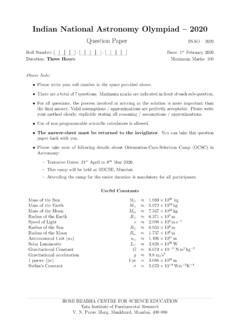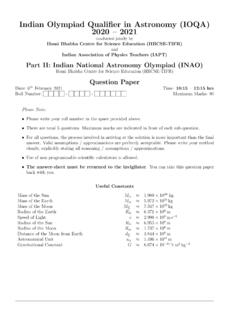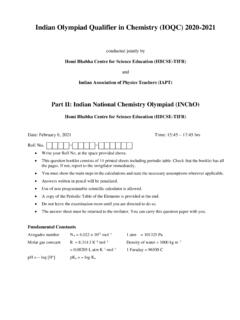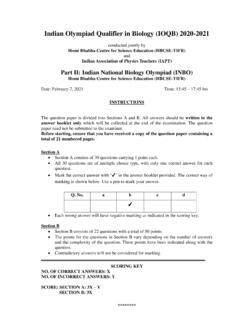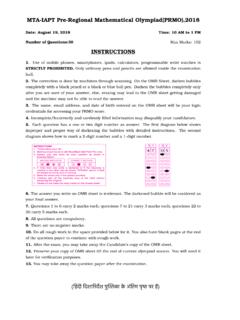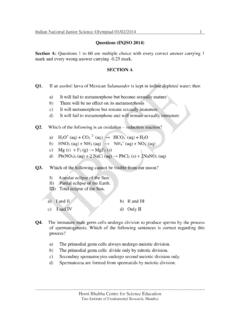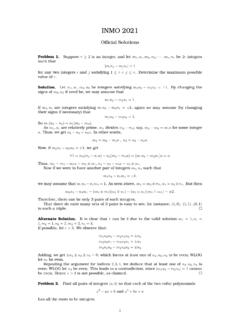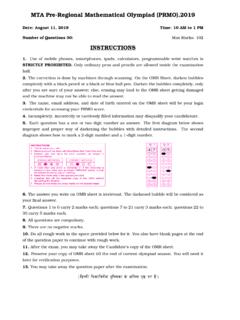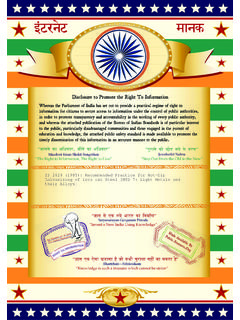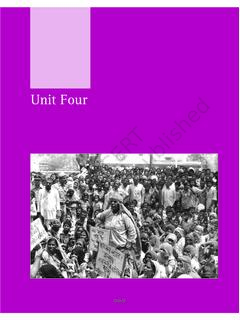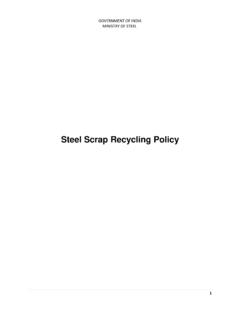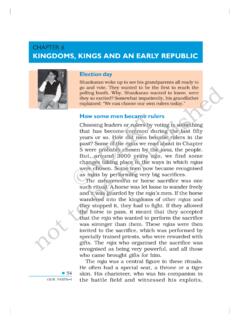Transcription of Indian National Junior Science Olympiad 2017
1 Indian National Junior Science Olympiad 2017 Roll Number: QUESTION PAPER INJSO 2017 Date: 28th January 2017 Duration: 3 Hours Maximum marks: 90 HOMI BHABHA CENTRE FOR Science EDUCATION Tata Institute of Fundamental Research V. N. PuravMarg, Mankhurd, Mumbai, 400 088 INSTRUCTIONS Please write your roll number on top of this page in the space provided.
2 Please use only black or blue pen to write your answers in the Answer Sheet provided. Please do not use a pencil. Before starting, please ensure that you have received a copy of this Question paper containing a total of 20 pages (20 sides on 10 sheets including the first 2 cover pages for instructions and values o f physical constants). In section A, there are 30 multiple choice questions with 4 alternatives, out of which only 1 is correct. You get 1 mark for every correct answer and mark for every wrong answer.
3 In Section B there are 12 questions of total 60 marks. For Section A, you have to indicate the answers on page 3 of the Answer sheet by putting a in the appropriate box against the relevant question number, like this: Q. No. (a) (b) (c) (d) 22 Marking a cross means affirmative response (making your particular choice). Do not use tick m a r k or any other signs to mark the correct answers. For each of the 12 questions in Section B, a separate page has been provided in the Answer sheet, with the particular question number indicated in the top left hand corner.
4 One additional page for answering those questions have also been appended, in case of necessity. A blank page have been provided in the Answer sheet, for rough work. Please write the answers in the answer sheet only. Calculator(s) and mobile phone(s) are not allowed. The Answer Sheet must be returned to the invigilator. You may take this Question paper with you. Indian National Junior Science Olympiad January 28, 2017 2 Homi Bhabha Centre for Science Education Tata Institute of Fundamental Research, Mumbai Useful Physical constants and Definitions (Many constants have been adjusted to make calculations simple in this examination) Gravitational Constant (G) = 10-11 m3kg-1s-2 Avogadro s number (N) = 1023 / mo l Gas constant (R)
5 = J mol-1 K-1, L atm K-1 mol-1 Mechanical equivalent of heat (Conversion factor for calorie) = J/cal Specific heat capacity of liquid water = 1 c a l / g C, kJ kg-1 K-1 Specific heat capacity of liquid heavy water = kJ kg-1 K-1 Specific heat capacity of frozen w a t e r = kJ kg-1 K-1 Latent heat for melting of water = 330 kJ kg-1 Latent heat for melting of heavy water = 3 40 k J kg-1 Specific latent heat for fusion of ice = 8 0 c a l / g Specific latent heat for boiling of water = 540 cal/g.
6 Heat of vaporization of water at 25 C = 4 20 00 J/mol Density of liquid water = g/cc; Standard pressure = 1 atm Density of liquid heavy water = g/cc; Standard temperature = 273 K Melting point of heavy water = 4 C; Volume of 1 mole of an ideal gas at = L Ore Chemical name Chalcocite Copper(I) sulphide Chalcopyrite Cupric ferrous sulphide Cinnabar Mercuric sulphide Covellite Copper(II) sulphide Galena Lead sulphide Goethite Ferric hydroxide oxide Hematite iron (III) oxide M a g n e t i te iron (II,III) oxide Sphalerite Zinc sulphide Zincblende Zinc sulphide 1 femtogram = 10-9 m i cr o g ra m , 1 m i c ro g r a m = 1 0-3 mg.
7 Element Relative Atomic Mass Atomic Weight Element Relative Atomic Mass Atomic Weight H 1 1 Li 6 3 C 12 6 Be 9 4 N 14 7 F 18 9 O 16 8 Cl 17 Na 23 11 Ca 40 20 Mg 24 12 Ba 137 56 S 32 16 Fe 56 26 B 10 5 K 39 19 Indian National Junior Science Olympiad January 28, 2017 3 Homi Bhabha Centre for Science Education Tata Institute of Fundamental Research, Mumbai SECTION A Questions 1 to 30 are Multiple Choice questions with every correct answer carrying 1 mark and every wrong answer carrying mark.
8 1. In an old Sherlock Holmes movie, a criminal kept a cm long knife (mass 1 kg), in a 15 cm thick book (excluding thickness of the covers) with a spring trap. The spring has 25 turns each of 1 mm thickness. The spring is fixed at the back cover and the knife presses the spring to its maximum when the front cover is closed so that the turns touch each other. The design is such that if the book is held in front of the body and opened, the knife gets detached from the spring and hits the reader (Sherlock Holmes i n this case).
9 Unstretched length of the spring is equal to thickness of the book. However, S h e r l o c k Holmes was too smart and hence he opened the book in such a way that the knife flew vertically upwards. All the energy of the spring is given to the knife, which just reached the ceiling, at a height of 5 m from the tip of the knife and got stuck there. Calculate the spring constant which satisfies the equation F = - kx. a) 160/9 N/mm b) 40/9 N/mm c) 40 N/mm d) N/mm 2. The focal length of a biconvex lens made of a soft material can be changed by changing its shape.
10 An object was brought from far away to near the biconvex lens. For each option given below, the first (left side) graph gives dependence of on as the shape of the lens is changed, and the second graph gives corresponding dependence of f on| |. Here u , v a n d f have standard meanings and all images are real. Which of the following options is the correct representation of that lens? 3. A b l a c k dot has a mass of about one femto gram. Assuming that the dot is made up of carbon only, calculate the approximate number of carbon atoms present in the dot.
